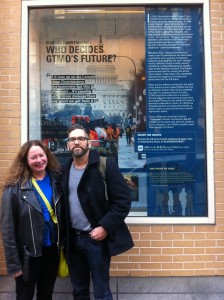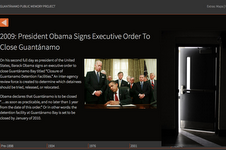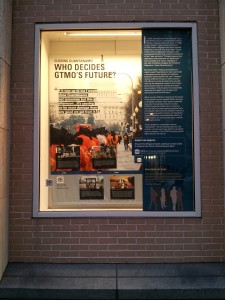The Guantánamo Public Memory Project travelling exhibit and national dialogue
15 July 2013 – Kevin Murphy
Editor’s Note: This piece continues a series of posts related to the Guantánamo Public Memory Project, a collaboration of public history programs across the country to raise awareness of the long history of the US naval base at Guantánamo Bay and foster dialogue on its future. For an introduction to the series, please see this piece by the Project’s director, Liz Ševčenko.

Kevin Murphy and Jean O’Brien standing beside the GPMP exhibit panel that resulted from their 2012 class. (Photo courtesy of Kevin Murphy)
In the past few months, the US Naval Station at Guantánamo has received increased coverage in the mainstream media due to news of a widespread hunger strike among those who remain detained there and grueling accounts of the invasive practice of force-feeding. This kind of media scrutiny was absent in the summer of 2012 as we prepared to involve University of Minnesota undergraduate students in an innovative public history project: The Guantánamo Public Memory Project Travelling Exhibit and National Dialogue (GPMP). Indeed, when we first met with the students who signed on to the project, a good number of them believed, like many Americans, that the prison had, or would soon be, closed. They shared negative perceptions of the site – seeing it as a place of harsh detention and as a problem for the United States’ international image – but few understood how Guantánamo came to occupy this place in the American past and present. Teaching a public history class on Guantánamo, then, meant engaging students in a very difficult and challenging set of issues that they felt was already being relegated to the past. As such, it served as an excellent site for promoting a broader conception of history as productive of and relevant to the politics of the present, and for inspiring public history students to see historical knowledge as absolutely essential to understanding – and changing – the world they live in.
The GPMP originated at the International Coalition of Sites of Conscience and was housed at the project Hub at Columbia University’s Institute for the Study of Human Rights. Under the leadership of Liz Sevcenko, the GPMP brought together eleven universities to produce the physical and digital content for a travelling exhibit on the long history of the US naval station at Guantánamo Bay, Cuba (heretofore, GITMO). The exhibit consists of twelve large panels with supporting digital projects, and includes a blog and website with rich content on the history of GITMO. The exhibit opened at the Kimmel Center at NYU in conjunction with a two-day conference that featured presentations by the student teams at each of the participating institutions as well as a rich roster of historians, former military personnel and families, lawyers involved in current-day struggles over human rights at GITMO, and other experts. Each institution signed on to offer a course for students on public history to produce exhibit content, to locate suitable exhibit space in their localities, and to offer ongoing program support for the exhibit and national dialogue. Faculty participating in the GPMP, fresh off of a fabulously stimulating and successful experience, hope that this will provide a blueprint for future collaborations in teaching and producing public history for us.
This path-breaking initiative created the context for the most satisfying pedagogical experience either of us has ever had, and at least a solid core of our students have described it as life-changing in empowering them to think critically about history, the world they live in, and the production of knowledge for public consumption. In terms of content, the project succeeded because it permitted all of us to historicize an event – post-9/11 detention practices at Guantánamo—that has largely been discussed and debated within a contemporary frame. In the process, participating students learned a great deal about the long and continuing history of U.S. imperialism. This education occurred not only through consuming the work of scholars (although consume we did), but also from the collective attempt to make historical sense of a seeming anomaly – the suspension of basic legal rights in a site that both is and is not part of the US. In addition, the fact that the prime objective of this course was to engage a broader audience in this complex history worked to inspire an intense commitment. Given the import of Guantánamo’s past and present, participating students and instructors worked to make sure that the history we presented could be accessed and actively engaged by diverse audiences. By and large, students learned about many of the major goals and methods of public history because they were passionate about the project, not simply because they were trying to satisfy course requirements or develop nominal professional skills.
At Minnesota, we team-taught a course of twenty-eight students who were charged with the task of creating a panel on the themes “Can we close Guantánamo” and “What are visions for Guantánamo’s future”? As instructors we faced the challenge of teaching this course to a group of mostly newcomers to public history with hard deadlines for content production that fell in the middle of the semester. We also came to the course not as experts on Guantánamo nor on digital public history, and we entered the semester faced with the challenge of finding a suitable location for the exhibit when it travelled to the Twin Cities.
On the first day students organized themselves into six groups: three groups drew on the materials provided by the GPMP Hub to produce elements of the physical exhibit; the other groups developed digital projects of their own devising relating to our assigned exhibit themes. Over the course of the semester we brought in specialists to talk about the history of Guantánamo Bay, about approaches to public history, about public policy, and about creating digital content. Our students were required to participate in the GPMP blog as entry producers and responders. As instructors, we identified possible venues for the exhibit, finally successfully negotiating with the Minnesota History Center to house the exhibit and work with us on associated public events, and we maneuvered the bureaucracy to arrange for the technical support our students needed to bring their digital projects to fruition. In the end, our students produced the block text, selected the images, and wrote captions for the exhibit panel. The digital groups produced three stunning projects: One used GIS mapping techniques (learned by two of their number in another course they took the same semester) to produce an interactive map of the location of Guantánamo detainees in 2002, 2006, and 2012; a second interviewed students on campus to produce an interactive word cloud that included video interviews and pop-up text; and the third produced an interactive project on the “almost closings” of GITMO over its long history. You can view the projects here.
Our course culminated in an Open House on our campus planned and executed by our own students with our guidance and vital assistance from campus technology experts. The event drew more than one hundred people on an icy December evening in Minneapolis. Students received both encouragement and invaluable critical feedback, and were able to share with friends, professors, and family their thoughts on the intensive work that they had done over the previous months. The fact that the students invested so fully in planning and promoting the Open House contributed to our sense that the project-based, flexible, pedagogical model that we used for this course had largely worked. This impression was confirmed by the student evaluations of the course; they were highly positive and expressed significant enthusiasm for the collaborative “shared authority.”
The day after the Open House, we led a group of eleven students on a trip to New York for the two-day academic conference, “Why Remember Guantanamo,” and exhibition opening. (This trip was made possible because of the generous support of our College of Liberal Arts and the Director of Undergraduate Studies in the History Department at the University of Minnesota). Our students attended every session, and presented their work in the closing session. Many of these students will continue to work with us to plan for the opening of the exhibit at the Minnesota History Center in February 2014.
We feel that this course succeeded for multiple reasons. First, it focused on a meaningful and complex history that resonates with big political and social issues of the present day. Second, it incorporated collaboration at multiple levels: among students; between students and faculty in multiple departments; and across a range of institutions of higher education. Finally, the course — and GPMP broadly – allowed students to learn about making public history by actively contributing to a project with a broad public audience. Of course, these high stakes caused much stress and trepidation for students and instructors alike, but they also encouraged students to see themselves as active producers of historical knowledge and allowed us to be bolder, more innovative, and more improvisational in our teaching.
In fall 2013, Kevin Murphy (with Jean O’Brien “shadowing”) will teach “Public History” again, this time as a graduate seminar, and the focus will be on Minnesota connections to “Guantánamo,” broadly defined. Students will develop projects that address the meanings and impacts of post-9/11 security and anti-terrorism policies in Minnesota as well as the connections between US immigration and citizenship policies and local refugee communities. Among other collaborations, we expect that students will work with veterans who served at Guantánamo, members of the local Somali and Muslim communities, and with individuals in groups who work on human rights issues at the UMN and within the community. The plan is that the resulting projects (most likely in digital format) will be incorporated into the exhibition and programming at the MHC.
As we move toward the fall course and the MHC exhibition opening, we face some significant challenges. As Omar Farrah of the Center for Constitutional Rights pointed out at the “Why Remember Guantánamo” conference, many members of surveilled populations, including Minnesota’s sizable East African community, have understandably proven reluctant to speak critically and publicly about post-9/11 detention practices. We will work this summer with graduate student Janeke Thumbran, and Somali-American undergraduate students at the University of Minnesota, to determine how we might incorporate their perspectives into the exhibition. Moreover, we face the general problem of finding collaborators and audiences for this project, given that some continue to see Guantánamo as an exceptional problem that will surely be “solved,”, even as detainees conduct hunger strikes to protest their detention. This last issue reflects a particular challenge for this project as well as for public historians in general: How do we incite acts of public remembering of events and practices that have been willfully consigned to the past?
~ Kevin P. Murphy and Jean M. O’Brien, University of Minnesota





